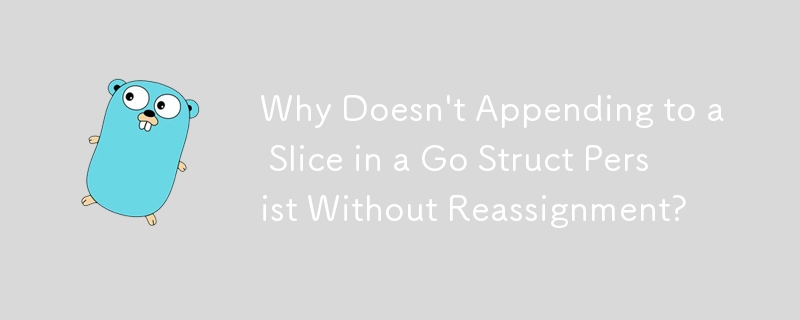 Backend Development
Backend Development
 Golang
Golang
 Why Doesn't Appending to a Slice in a Go Struct Persist Without Reassignment?
Why Doesn't Appending to a Slice in a Go Struct Persist Without Reassignment?
Why Doesn't Appending to a Slice in a Go Struct Persist Without Reassignment?

Go - Appending to a Slice Within a Struct
In Go, slices are reference types, meaning that they hold a reference to the underlying array. If you append an element to a slice within a struct and do not assign the result back to the slice, the changes will not be persisted when the function returns.
Consider the following code:
type MyBoxItem struct {
Name string
}
type MyBox struct {
Items []MyBoxItem
}
func (box *MyBox) AddItem(item MyBoxItem) []MyBoxItem {
return append(box.Items, item)
}Here, the AddItem method takes an item and appends it to the slice of items in the box struct. However, the method does not assign the result back to the Items slice, which means that the slice will not be modified when the method returns.
To fix this, you need to assign the result of the append operation back to the slice. You can do this by modifying the AddItem method as follows:
func (box *MyBox) AddItem(item MyBoxItem) {
box.Items = append(box.Items, item)
}Now, when you call the AddItem method, the slice will be updated within the struct. You can verify this by calling the len function on the Items slice:
item1 := MyBoxItem{Name: "Test Item 1"}
item2 := MyBoxItem{Name: "Test Item 2"}
items := []MyBoxItem{}
box := MyBox{items}
box.AddItem(item1)
fmt.Println(len(box.Items)) // Output: 1Note that the AddItem method is defined for the *MyBox type, which means that you must call it as box.AddItem(item1), passing a pointer to the box struct as an argument.
The above is the detailed content of Why Doesn't Appending to a Slice in a Go Struct Persist Without Reassignment?. For more information, please follow other related articles on the PHP Chinese website!

Hot AI Tools

Undresser.AI Undress
AI-powered app for creating realistic nude photos

AI Clothes Remover
Online AI tool for removing clothes from photos.

Undress AI Tool
Undress images for free

Clothoff.io
AI clothes remover

AI Hentai Generator
Generate AI Hentai for free.

Hot Article

Hot Tools

Notepad++7.3.1
Easy-to-use and free code editor

SublimeText3 Chinese version
Chinese version, very easy to use

Zend Studio 13.0.1
Powerful PHP integrated development environment

Dreamweaver CS6
Visual web development tools

SublimeText3 Mac version
God-level code editing software (SublimeText3)

Hot Topics
 How do I write mock objects and stubs for testing in Go?
Mar 10, 2025 pm 05:38 PM
How do I write mock objects and stubs for testing in Go?
Mar 10, 2025 pm 05:38 PM
This article demonstrates creating mocks and stubs in Go for unit testing. It emphasizes using interfaces, provides examples of mock implementations, and discusses best practices like keeping mocks focused and using assertion libraries. The articl
 How do you write unit tests in Go?
Mar 21, 2025 pm 06:34 PM
How do you write unit tests in Go?
Mar 21, 2025 pm 06:34 PM
The article discusses writing unit tests in Go, covering best practices, mocking techniques, and tools for efficient test management.
 How can I define custom type constraints for generics in Go?
Mar 10, 2025 pm 03:20 PM
How can I define custom type constraints for generics in Go?
Mar 10, 2025 pm 03:20 PM
This article explores Go's custom type constraints for generics. It details how interfaces define minimum type requirements for generic functions, improving type safety and code reusability. The article also discusses limitations and best practices
 How do you use the pprof tool to analyze Go performance?
Mar 21, 2025 pm 06:37 PM
How do you use the pprof tool to analyze Go performance?
Mar 21, 2025 pm 06:37 PM
The article explains how to use the pprof tool for analyzing Go performance, including enabling profiling, collecting data, and identifying common bottlenecks like CPU and memory issues.Character count: 159
 How can I use tracing tools to understand the execution flow of my Go applications?
Mar 10, 2025 pm 05:36 PM
How can I use tracing tools to understand the execution flow of my Go applications?
Mar 10, 2025 pm 05:36 PM
This article explores using tracing tools to analyze Go application execution flow. It discusses manual and automatic instrumentation techniques, comparing tools like Jaeger, Zipkin, and OpenTelemetry, and highlighting effective data visualization
 Explain the purpose of Go's reflect package. When would you use reflection? What are the performance implications?
Mar 25, 2025 am 11:17 AM
Explain the purpose of Go's reflect package. When would you use reflection? What are the performance implications?
Mar 25, 2025 am 11:17 AM
The article discusses Go's reflect package, used for runtime manipulation of code, beneficial for serialization, generic programming, and more. It warns of performance costs like slower execution and higher memory use, advising judicious use and best
 How do you specify dependencies in your go.mod file?
Mar 27, 2025 pm 07:14 PM
How do you specify dependencies in your go.mod file?
Mar 27, 2025 pm 07:14 PM
The article discusses managing Go module dependencies via go.mod, covering specification, updates, and conflict resolution. It emphasizes best practices like semantic versioning and regular updates.
 How do you use table-driven tests in Go?
Mar 21, 2025 pm 06:35 PM
How do you use table-driven tests in Go?
Mar 21, 2025 pm 06:35 PM
The article discusses using table-driven tests in Go, a method that uses a table of test cases to test functions with multiple inputs and outcomes. It highlights benefits like improved readability, reduced duplication, scalability, consistency, and a






